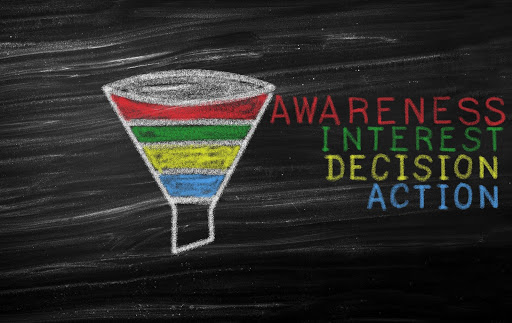Subscribe to stay on top of our latest content!
Share this article
A sales funnel describes the ways in which consumers move through the buying process, going from a site or store visitor (of which there is a higher percentage) to a paying customer (of which there is a lower percentage). This is where the ‘funnel’ depiction comes from: a higher number of customers enter the top of the funnel but only a few will make it all the way down to the bottom by making a purchase.
Between the top and bottom of the funnel are a number of steps, and by understanding each of them, you may be able to impact consumer behaviour and use certain tactics to encourage more visitors to get down to the bottom of the funnel and reach the end goal of becoming a paying customer.

Written by Lauren Shaw
Marketing Manager
Published: 20/04/2021
What are the four sales funnel stages?
When you’re creating your sales funnel, it’s important to remember the four individual stages that are collectively known as ‘AIDA’:
- Awareness
- Interest
- Decision
- Action
Each of these describes a stage that every consumer goes through to become a paying client. Many marketers apply these to their sales funnel to increase conversions and sales, but what do each of these things mean?

Stage 1: Awareness
This first stage is all about creating brand awareness and attracting the customer’s attention. This can be done through advertising, videos, PR, graphics, social media posts, etc.
Stage 2: Interest
Once their attention has been caught, you need to pique their interest and make them want to invest in your product or service. This can be done by explaining the benefits of the product or service and how it can help them. The way in which you do this should encourage them to do further research.
Stage 3: Decision
This is the point at which a customer will make their decision. There are lots of factors to be considered here. The customer may go with another product or service if they’ve found one that’s cheaper or another company offers free delivery, for example. They may choose another competitor who has better reviews. In order to ensure that they make their decision to purchase through your business, you should try to make your best offer. This could be free delivery, a discount or a small free product when they make a purchase.
Stage 4: Action
At this stage, the user takes an action. This could be requesting a quote, paying a deposit or actually purchasing a product.
How to create a sales funnel
Creating a sales funnel may seem like a daunting task, but ultimately, it involves finding your target audience, ensuring that they hear about your products or services and encouraging them to make a purchase. Below, you can find each of the steps involved to create the perfect sales funnel to hopefully increase conversions.
Step 1: Research
Before you can hope to increase sales, it’s important to make sure you’re targeting the right audience and market. When creating the first stage of the sales funnel, you should conduct some research around your target audience to find out what their problems and pain points are, what their interests are and where they can be found. For more information on how to do this, you can read our guide on identifying your target audience. It can also be used to create buyer personas and profiles, something that is quite important if you wish to understand your ideal customer.
Step 2: Find potential customers
Now that you know who your target audience is, it’s time to find them so that they can enter the sales funnel and start the process of becoming a potential customer. Generally, it can take some time to build a relationship between buyers and a brand, and you want to show them how your product or service can solve the problem they’re facing. You can do this by putting your brand directly in front of them, either through content marketing strategies, PPC (pay-per-click) campaigns, social media advertising and more. These things can all drive relevant traffic to your website, and when this happens, the consumer has entered the first stage of the funnel.
Step 3: Make them interested
Once you have visitors either visiting your website or coming into your brick-and-mortar premises, it’s time to encourage them to make a purchase or even become a lead by filling out an online form or signing up for a mailing list. The best way to do this is by making them even more interested in your product or service. This can be done by writing relevant and engaging blog posts, promoting social media posts or creating fun and informative videos. This is all beneficial to build the potential customer’s trust in your brand over time and make them more likely to convert.
Step 4: Convert them to leads
While it’s great to have website users and social media followers who are interested in what you’re putting out there, you want to be able to convert them into a lead. A person usually becomes a lead when they provide their details in exchange for something. For example, they may fill out an online form requesting a quote, sign up to your mailing letter or enter their email address in a giveaway you’re promoting on social media. All of these things provide what you need the most: a way to contact them.
Once an email address has been provided and you’ve got some additional information about them, you can begin to send out promotional material. This could be via a phone call, email or other method. A CRM system can be used to track leads and ensure that you never forget to follow up with them to encourage them to convert to a customer. Don’t forget that if you do use a CRM, you may be able to set up a funnel so that the entire process can be automated.
Step 5: Convert leads into buyers
It’s important to keep in regular contact with leads so that they don’t slip away. After the initial consultation with a lead, you should make a follow-up call or send an email. A CRM system can automatically alert you when this follow up needs to be made so that your sales team never forget.
There are other ways to increase the chances of leads converting, too. You can send them a discount code for a set of products they were looking at, make the online checkout process really user friendly, reduce the number of fields to fill out on an online form and add a live chat to your site so any issues can be ironed out instantly.
Written by Lauren Shaw, Marketing Manager at FLG.
Find out how FLG can help your business
Schedule a demo and let us show you around our CRM platform
Request a demo